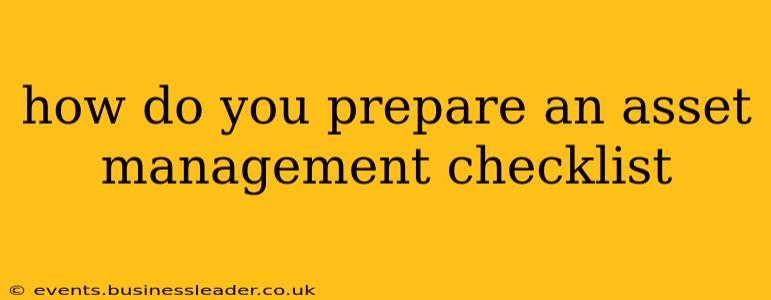How to Prepare a Comprehensive Asset Management Checklist
Effective asset management is crucial for any organization, regardless of size or industry. A well-structured checklist streamlines the process, minimizing risks and maximizing the lifespan and value of your assets. This guide outlines how to prepare a comprehensive asset management checklist, covering various aspects from initial acquisition to eventual disposal.
What is an Asset Management Checklist?
An asset management checklist is a structured document outlining all the necessary steps involved in managing an asset throughout its lifecycle. This includes acquisition, maintenance, usage tracking, and eventual disposal. A robust checklist ensures consistency, reduces errors, and promotes efficient resource allocation.
I. Acquisition & Onboarding:
1. Needs Assessment & Budget Allocation:
- Clearly define the need: What problem will this asset solve? What are its key functionalities?
- Research & Selection: Compare different options, considering cost, functionality, and long-term maintenance. Document your decision-making process.
- Budget Approval: Secure necessary funding and approvals for the purchase.
- Supplier Selection & Contract Negotiation: Choose a reliable supplier and negotiate favorable terms.
2. Acquisition & Documentation:
- Purchase Order & Invoice Verification: Ensure accurate records of transactions.
- Detailed Asset Information: Record asset name, model number, serial number, purchase date, vendor information, and cost. Use a centralized database or spreadsheet.
- Warranty & Maintenance Agreements: Document all warranties, service contracts, and maintenance agreements.
- Initial Inspection: Perform a thorough inspection upon receipt to identify any defects or damage. Document findings.
II. Ongoing Management & Maintenance:
3. Asset Tagging & Inventory:
- Unique Identification: Assign a unique identification number or barcode to each asset.
- Physical Inventory: Conduct regular physical inventories to verify asset location and condition.
- Inventory Database: Maintain an up-to-date digital inventory database for easy access and tracking.
4. Regular Maintenance & Inspections:
- Preventive Maintenance Schedule: Establish a schedule for routine maintenance and inspections based on manufacturer recommendations.
- Inspection Reports: Document all inspections, including findings, repairs performed, and any necessary actions.
- Corrective Maintenance: Address any issues identified during inspections promptly and efficiently.
5. Usage Tracking & Reporting:
- Usage Logs: Track asset usage to monitor performance, identify potential issues, and optimize resource allocation.
- Performance Metrics: Define key performance indicators (KPIs) to track asset efficiency and effectiveness.
- Regular Reports: Generate reports to monitor asset health, usage patterns, and overall performance.
III. Disposal & Decommissioning:
6. Asset Retirement Planning:
- Determine Asset Lifecycle: Estimate the useful life of the asset.
- Depreciation Schedule: Accurately track depreciation for accounting and tax purposes.
- Replacement Planning: Plan for replacement well in advance to minimize disruption.
7. Disposal & Decommissioning:
- Data Erasure/Sanitization: Securely erase any sensitive data stored on the asset before disposal.
- Asset Disposal Methods: Choose an appropriate disposal method (e.g., sale, donation, recycling, scrapping).
- Documentation & Record Keeping: Maintain accurate records of asset disposal, including date, method, and recipient.
IV. Software & Technology Integration:
8. CMMS Software: Consider using Computerized Maintenance Management System (CMMS) software to streamline asset management processes.
9. Integration with Accounting Systems: Integrate your asset management system with your accounting system for accurate financial reporting.
V. Frequently Asked Questions (PAAs):
What software is best for asset management? The best software depends on your specific needs and budget. Research different options, considering factors such as scalability, integration capabilities, and user-friendliness.
How often should I conduct asset inventories? The frequency of inventories depends on the type and criticality of your assets. High-value or critical assets may require more frequent checks.
How do I calculate asset depreciation? Depreciation methods vary depending on accounting standards. Consult with an accountant or financial professional for guidance.
What are the legal implications of asset disposal? Legal requirements for asset disposal vary depending on the type of asset and local regulations. Ensure compliance with all relevant laws and regulations.
How can I improve asset utilization? Track asset usage, identify underutilized assets, and optimize resource allocation to improve utilization rates.
By following this comprehensive checklist and adapting it to your organization's specific needs, you can establish a robust asset management system that enhances efficiency, reduces risks, and maximizes the value of your investments. Remember that regular review and updates to your checklist are crucial to maintain its effectiveness.
